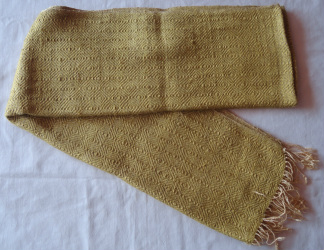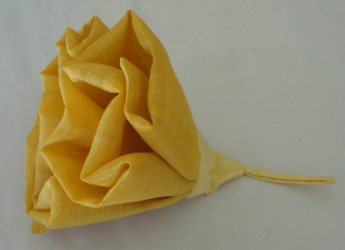 Golden silk shawl scarf
Golden silk shawl scarf
GOLDEN COCOON ORGANIC SILK SCARVES
Ethically hand-woven by women weavers in Phnom Srok, Kingdom of Cambodia.
Cambodian culture has a long been associated with the production of silk and fine silk fabrics such as those used in these scarves. The Cambodian silk industry has survived the country’s political unrest and civil war and is now very much alive. It is generally believed that growing mulberry plants, silk worm breeding and silk weaving was introduced to Cambodia in the 13th century.
Then, in the late 19th century and continuing through the two World Wars, sericulture ( silk farming ) developed even further. World War II caused a shortage of fabric in European countries, which consequently accelerated its growth in Cambodia. Mulberry plantations reportedly covered a total of five to six thousand hectares, and yarn production eventually reached 150 tons per year at the end of World War II.
At that time, 10 to 30 percent of families worked in this golden silk industry; Women bred silk worms and wove their cloth for traditional skirts, shirts. These fine garments were especially favored by Royal families and dignitary. Now these beautiful garments are worn by many Cambodian ladies and men at traditional weddings or special events. The techniques of mulberry growing, breeding the silk worms and weaving the yarn were passed from one generation to the next and from mother to daughter Young girls learned sericulture by helping with those tasks of which they were capable. By the time they were about 12 years old, when their mothers felt that they had the skills they needed and if there were enough mulberry trees to sustain a second batch, these girls tried their own hand at breeding worms and weaving
The, Golden Cocoon Silk Collection , is inspired by the local organic silk which is hand-dyed and hand-woven using only natural dyes/colors. The communities for this collection is the only revival area of the Golden silk yarn production in Cambodia.
Ethically hand-woven by women weavers in Phnom Srok, Kingdom of Cambodia.
Cambodian culture has a long been associated with the production of silk and fine silk fabrics such as those used in these scarves. The Cambodian silk industry has survived the country’s political unrest and civil war and is now very much alive. It is generally believed that growing mulberry plants, silk worm breeding and silk weaving was introduced to Cambodia in the 13th century.
Then, in the late 19th century and continuing through the two World Wars, sericulture ( silk farming ) developed even further. World War II caused a shortage of fabric in European countries, which consequently accelerated its growth in Cambodia. Mulberry plantations reportedly covered a total of five to six thousand hectares, and yarn production eventually reached 150 tons per year at the end of World War II.
At that time, 10 to 30 percent of families worked in this golden silk industry; Women bred silk worms and wove their cloth for traditional skirts, shirts. These fine garments were especially favored by Royal families and dignitary. Now these beautiful garments are worn by many Cambodian ladies and men at traditional weddings or special events. The techniques of mulberry growing, breeding the silk worms and weaving the yarn were passed from one generation to the next and from mother to daughter Young girls learned sericulture by helping with those tasks of which they were capable. By the time they were about 12 years old, when their mothers felt that they had the skills they needed and if there were enough mulberry trees to sustain a second batch, these girls tried their own hand at breeding worms and weaving
The, Golden Cocoon Silk Collection , is inspired by the local organic silk which is hand-dyed and hand-woven using only natural dyes/colors. The communities for this collection is the only revival area of the Golden silk yarn production in Cambodia.

THE REVIVAL OF SILK FARMING
The only cocoon silk yarn production zone that remained in Cambodia after the wars and political unrest was based in Phnom Srok district (about 75km northwest of Siem Reap town). It included around 200- 250 women growers, many of whom increased the value of their cocoon yarn by weaving. However, the total production of raw silk did not exceed 800 Kg per year.
This zone began to revitalize the silk sector in Siem Reap province and Phnom Srok district. This area was fortunately spared from the disruption experienced in Cambodia, both the fighting and forced evacuations under the notorious Khmer Rouge regime. Thus, the villagers involved in sericulture did not lose their mulberry plantations and culture, silkworm breeding stock and the means of producing and weaving this beautiful yarn.
The only cocoon silk yarn production zone that remained in Cambodia after the wars and political unrest was based in Phnom Srok district (about 75km northwest of Siem Reap town). It included around 200- 250 women growers, many of whom increased the value of their cocoon yarn by weaving. However, the total production of raw silk did not exceed 800 Kg per year.
This zone began to revitalize the silk sector in Siem Reap province and Phnom Srok district. This area was fortunately spared from the disruption experienced in Cambodia, both the fighting and forced evacuations under the notorious Khmer Rouge regime. Thus, the villagers involved in sericulture did not lose their mulberry plantations and culture, silkworm breeding stock and the means of producing and weaving this beautiful yarn.

